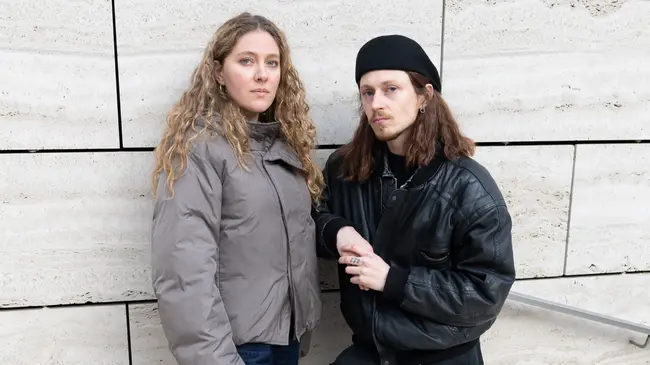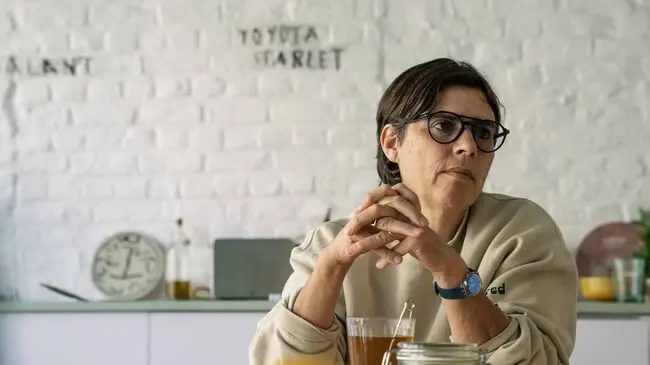A dance between being very careful and not careful at all

Antwerp-based artist Ayrton Eblé creates his artworks by exploring the limits of what is understood as art and its relationship with the urban setting and architecture. During our visit to Jacques Moeschal's exhibition at Bozar, while discovering the monumental sculptures that were once part of the Belgian landscape, we talked about new ways of perceiving the city, spontaneous collaborations and future projects.
How would you describe your work nowadays?
I like to see myself and my work as mediators between architecture and art. I’m not an architect but I have an architectural approach. I take a deep look into materials and see how to take them to their limit. I know how certain materials react and I like to push them to the point where they don’t work as expected anymore. For one of my pieces, ‘Deconstruction Painting #1’, I poured a very thin layer of cement on the backside of a canvas. Then, I cut out from the front so I could peel the fabric off the poured concrete. The poured concrete sort of crumbled and left marks, creating a nice pattern. In a certain way, I like sabotaging my own work. I try mostly not to paint and let the materials speak for themselves.
In a certain way, I like sabotaging my own work
What about your process? Are there steps that you always follow?
I often visit construction sites for inspiration. There is so much construction work going on nowadays. If you look at those construction sites in a certain way, you can discover paintings and sculptures. It takes a different way of looking at it and this fascinates me. There is a certain logic in the marks that the construction workers make, for example. It’s beautiful how these elements, such as neon and concrete, react with each other. I sometimes copy techniques I find at these sites whilst combining them with my knowledge of painting. I try new techniques and approaches with every piece that I make. Sometimes a method fails but then I’ll try to incorporate this into the next work and so on.
What are the things that have been inspiring you the most?
I’ve been photographing a lot. When walking in the street I’m always looking for some solutions - small-scale interventions that attempt to solve a spatial urban issue in an eccentric manner. At some point, I realized that I couldn’t walk on the street without constantly taking photographs with my phone and I decided to switch to a simple point-and-shoot analogue camera. That’s the only thing I use to take those pictures nowadays because otherwise, it would become too much of an obsession. These photographs have now become a personal archive from which I draw a lot of inspiration.
What did you think about the exhibition?
I really enjoyed it. I even bought the exhibition’s book! [Laughs] It was very interesting, especially for Brussels itself. I want to have a tour to check out Moeschal’s sculptures around the city.
Jacques Moeschal works with the relationship between man and the urban setting. Do you also see this relationship as an important aspect of your own work?
I’m shifting the direction I want to take my work. I feel a strong urge to make more temporary interventions and sculptures in public spaces. It has been nice to work in this kind of setting and I believe I want to go more in this direction. After some experiences posting my pictures of construction sites on Instagram, for example, I realized I had an influence on the way people look at those places themselves. I believe this can create a new way of perceiving the city. I try to make people look at the constantly changing surroundings around them. I really enjoyed this and tend to explore it even more.
I try to make people look at the constantly changing surroundings around them
You’ve mentioned that you see yourself exhibiting your art in public spaces just like some of Moeschal’s works…
It was fascinating to see how the work of Jacques Moeschal is strongly connected to architecture. He managed to incorporate his sculptures in architectural projects and I want to try to incorporate my work in that way as well. During the weekends, I usually go to the construction sites I talked about. I move stuff around and build installations for the construction workers to find. Sometimes I work with texts and I once wrote something on a concrete pipe that goes into the ground. A part of the text wasn’t readable, and the construction workers dug into the sand to be able to read it fully. This ended up being one of the best collaborations I’ve ever done [Laughs]. There are many things I do outside that I don’t necessarily claim. I like to make things look like they were already there, and it takes a lot of understanding to make something seem like a natural part of a setting.
Different Class works with the interest of their community at heart.
Our work’s purpose is to foster a solid network for independent artists, those who love them, and those who want to support them. Become a member to contribute to the local Belgian art scene.





